
THE OLD TOWN SQUARE IN PRAGUE
This square is called "staromĕstské námešti" in Czech, which can be directly translated into English, as "staromĕstské" is composed by "old" and "town". In older days this was a most important market square.
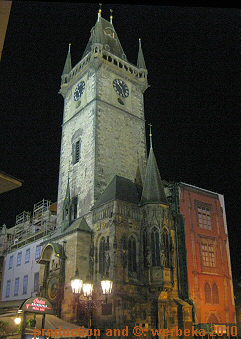 |
The best known building on the square is probably the tower of the city hall with its astronomical clock. Already in 1338 Prague got the rights to build a city hall of its own and the tower actually dates back to that times. The clock is a little younger, it was built in 1410 by Mikuláš z Kadanĕ after calculations of the astronomer Jan Šindel. Eighty years later Master Hanuš fullfilled the work.
Again the linguist, that I am, reacts on the clock being called "Orloj" in the Czech language.
|
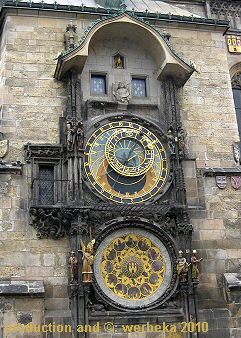 |
The word has its source in the Latin word "horologium". In Italian it still today called "orologio" and in French "horloge" means a big clock. Even the English word "hour" is derived from its Latin mother. That a Slavic language, like Czech has borrowed a word with Latin source, is probably due to that the first clocks were constructed in Italy. But now let us get back quickly to the Staromĕstské námešti:
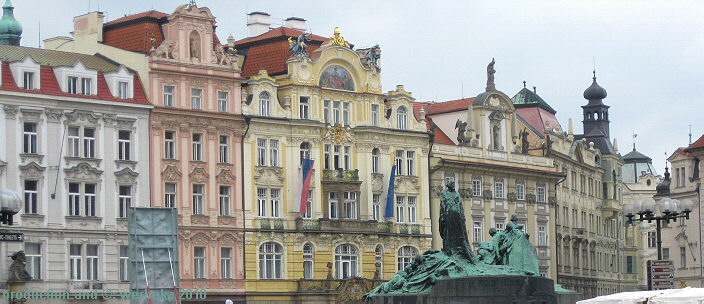
Many of the houses around and in the vicinity of the square stand on romanic or gothic foundations, which means, that the area was inhabited already a thousand years ago. In the middle of the square there is a monument - a group erected by Ladislav Šaloun in 1915, in honour of Jan Hus, the founder of the bohemian reformation.
This man was inspired by the writings of an Englishman, John Wyclif, which resulted in Hus' rejection of the Pope and his criticism of the clerics' greediness and their depraved way of life. That, of course, didn't make him very popular, even if he a part of the time was supported by the nobility, the latter expecting to get hold of some of the treasures of the church. But it must also be mentioned that during the very most of the 14th century there were two popes and at the beginning of the 15th century even three of them. Nevertheless Hus was excommunicated in 1411 and banned from Prague. In 1415 he was burned at the stake for his heretic deeds.
But Jan Hus was not only active on the field of religion, he had a big part in developing the Czech literary language. As a teacher and later as headmaster of the university he established the "haček", a diacritical sign that softens consonants, as well as the acute accent, which lenghtens vowels.
| Apart from this he is somewhat like a Czech national hero, because he stood in opposition to the - mostly German speaking - profane and clerical suzerain.
On the Old Town Square even the two churches must be mentioned, which to such a high degree define the appearence of the place. The start of the building of the gothic Tynchurch, devoted to Virgin Mary, dates back to 1365. This church dominates the Staromĕstské námešti, even though it doesn't stand directly on the square, but with its towers looks over the two houses in front of it. The right tower is a little bulkier is called Adam, whereas the more slender Eve stands to the left of him (as seen from the Square). The Czech "tyn" has the same morphological stem as the German "Zaun (=fence)" and has its origin in the fact that one here once collected customs duty.
In the inner part of the church you can find quite some treasures, partly from the early 15th century. Furthermore the Dane Tycho Brahe, the Royal Court Astronomer of Emperor Rudolf II, is buried here. He was the teacher of Johannes Kepler. |
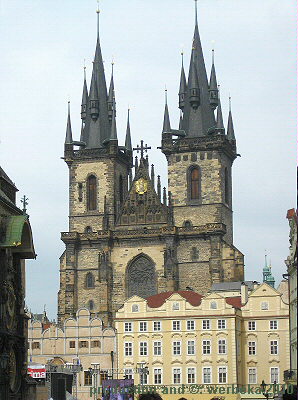 |
| The second church, bordering the square immediately, is the baroque St. Nikolas-church. It was erected in the 18th century by Kilian Ignaz Dienzenhofer, as an replacement for the older, romanic church, standing on the very same place, but which was destroyed by a fire. It has, in spite of its rather short existence, a rather varied history. As part of a monastery it became a storehouse under the era of Emperor Joseph II, when many abbeys were closed. Later it was used as a military church. In 1871 it was taken over by the Russian-Orthodox denomination, but already in 1920 it became the Lord's house of the Czech Hussites, which were founded here at that time. This closes also the circle back to Jan Hus.
The Kinsky-palace, also situated on the square, was equally projected by Dienzenhofer, but accomplished by Anselmo Lurago. It has gone to history in 1948, when the coming into power of the Communist party was announced from there. |
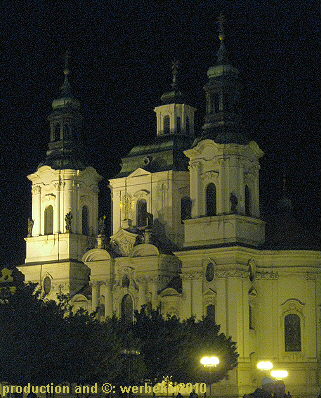 |
Copyright Bernhard Kauntz, Wolvertem 2010
Back to  or to the or to the  of of 
last update: 22.5.2010 by webmaster@werbeka.com
|







